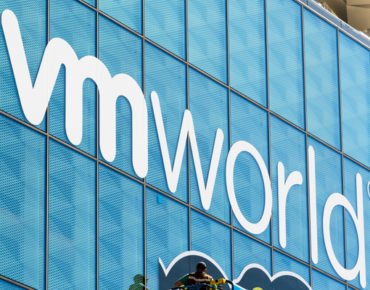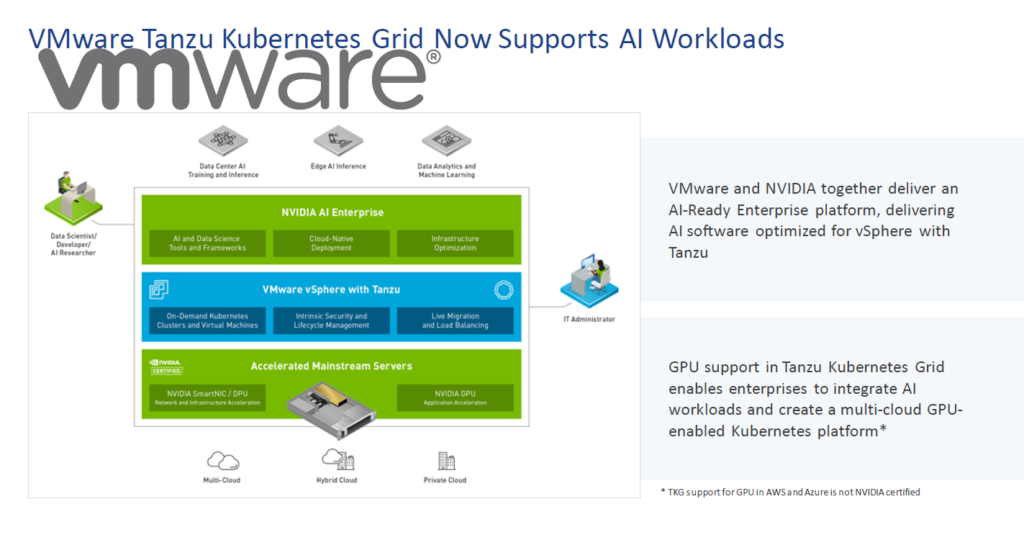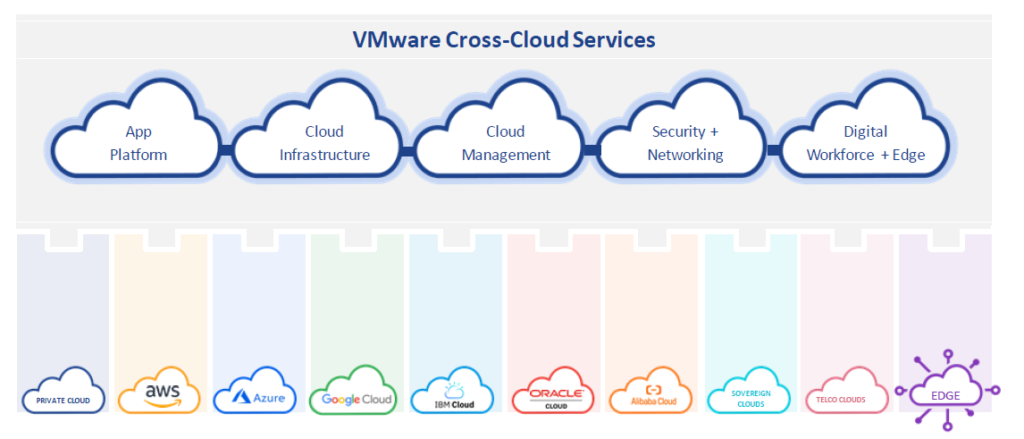At VMworld 2021, VMware, Nvidia, Dell Unveil Deeper Cloud, Edge, Kubernetes Partnerships

From new enterprise cloud capabilities to deeper features for edge computing applications to broader Kubernetes usability, there is something to help every business at this year’s VMworld 2021 virtual technology conference.
Opening the event are announcements from VMware and partners Nvidia and Dell aimed at offering enterprise customers easier, stronger and more secure ways to configure and use the cloud while also boosting a wide range of other business-critical IT systems. The annual VMworld conference, sponsored by VMware, is being held virtually around the globe due to the lingering COVID-19 pandemic and runs from Oct. 5 to 7.
For VMware, the event’s big news today centers on the announcement of its new VMware Cross-Cloud services offerings; new features in its VMware Tanzu application; an all-new, free-to-use Tanzu Community Edition and a new VMware Edge product line that gives enterprises broader capabilities to run, manage and secure edge-native applications across multiple clouds anywhere. The updates will broaden capabilities for enterprise customers that use the VMware vSphere virtualization platform with Tanzu, which allows companies to run Kubernetes workloads on existing infrastructure.
In conjunction with the latest Tanzu features, partner Nvidia announced new integrations with its Nvidia AI Enterprise software suite that will allow customers to run trials of their AI projects using vSphere with Tanzu.
Nvidia also unveiled that computer-maker Lenovo has joined Nvidia’s early access program for VMware’s year-old Project Monterey technology preview that aims to extend the reach of Nvidia BlueField Data Processing Unit-Powered VMware hybrid clouds. Project Monterey, which is still in development, aims to make it easier for enterprises to respond to constantly-changing architecture requirements for AI, machine learning, 5G applications and more.
Dell’s announcements at VMworld centered around the pairing of Dell APEX cloud services with VMware Cloud to help customers gain simplified multi-cloud capabilities, as well as new Dell EMC ObjectScale software that uses Kubernetes to reduce object storage costs while accelerating application creation. Dell Technologies also unveiled its new Validated Design for AI program, which was jointly engineered with VMware and Nvidia, to help enterprises gain more insights from their data.
VMware Cross-Cloud Services and More
Designed to bring greater cloud freedom, flexibility and security for customers, the new VMware Cross-Cloud services portfolio is aimed at helping enterprises better deal with the more than 500 applications the average organization is running today across multiple clouds, said the company.
“Multi-cloud is the digital business model for the next 20 years, as entire industries reinvent themselves,” Raghu Raghuram, VMware’s chief executive officer, said in a statement. “It’s no longer about a ‘cloud first’ approach – it’s about being ‘cloud smart.’ With our cloud-agnostic approach, we are uniquely positioned to meet our customers where they are and take them where they want to go. We give every organization the power to accelerate their innovation and control their own destiny in the multi-cloud era.”
The VMware Cross-Cloud services are designed to expand VMware’s capabilities for a multi-cloud world while allowing customers to choose the services they need on the cloud they want to use, according to the company. The services include a platform where cloud-native apps can be built and deployed; cloud infrastructure to run enterprise apps; cloud management for monitoring and fine-tuning the performance and cost of apps across different clouds; security and networking; and edge capabilities to deploy and manage edge-native apps.
Tanzu Advancements
VMware is continuing the development of its fledgling Tanzu Kubernetes application platform at VMworld 2021 by introducing broad improvements for enterprises that want to dive more deeply into better management of their VMware and Kubernetes investments.
The Tanzu Application Platform, which was introduced as a beta product at VMware SpringOne 2021, gets a host of improvements, including new supply chain choreography that allows app operators to create pre-approved paths to production for developers that integrate Kubernetes resources and existing toolchains; new developer tools including IDE plugins that give developers opportunities to interact with the platform or its open-source components more easily to execute important and frequent pre-commit development tasks; and new service bindings that permit developers to specify how endpoints and credentials from data services are exposed to workloads in portable and Kubernetes-native ways.
 Also new for Tanzu customers is the announcement of free access to a first-ever, open source VMware Tanzu Community Edition, which will allow customers to run and manage Kubernetes-based containerized apps at no cost in multi-cloud environments.
Also new for Tanzu customers is the announcement of free access to a first-ever, open source VMware Tanzu Community Edition, which will allow customers to run and manage Kubernetes-based containerized apps at no cost in multi-cloud environments.
The VMware Tanzu Community Edition aims to give developers the chance to explore the capabilities of Tanzu using a free, open source version that has no usage restrictions or functional limitations so they can see how it could help their enterprises.
In connection with the free edition, VMware is also providing a free starter tier of VMware Tanzu Mission Control to provide multi-cloud, multi-cluster Kubernetes management as a SaaS service.
VMware at the Edge
The company’s new VMware Edge portfolio aims to help organizations run, manage and secure their edge-native apps across multiple clouds by bringing together products from across the company, including the all-new VMware Edge Compute Stack, which is an integrated VM and container-based stack that enables organizations to modernize and secure edge-native apps at the far edge. It will be available in standard, advanced and enterprise editions, as well as in a lightweight version for lightweight apps.
Other VMware Edge products include VMware SASE, which combines SD-WAN capabilities with cloud-delivered security functions that are delivered as-a-service across both the near and far edge locations through a global network.
Also unveiled at VMworld are new security features including secure workload access for Zero Trust inside clouds and data centers, elastic application security edge for stronger and more flexible cloud-to-cloud security and VMware Cloud Disaster Recovery and VMware Carbon Black Cloud services for ransomware protection and recovery.
Nvidia and VMware Continue to Integrate Tanzu Services
In March, Nvidia and VMware announced that they were working to bring together VMware Tanzu capabilities with Nvidia’s nascent AI Enterprise software suite.
At VMworld 2021, the two companies announced an upcoming update that will allow enterprises to run trials of their AI projects using vSphere with Tanzu in conjunction with the Nvidia AI Enterprise software suite, which became available in August. The Nvidia AI Enterprise suite is a cloud-native suite of AI and data analytics frameworks and tools optimized, certified and supported by Nvidia to enable the rapid deployment, management and scaling of AI applications in hybrid clouds.
“With Nvidia AI Enterprise and VMware vSphere with Tanzu, customers can manage AI development and deployment on mainstream data center servers and clouds, making it easy to integrate the AI applications powering growth in every industry,” Lee Caswell, vice president of marketing for VMware’s cloud infrastructure business group, said in a statement.
Nvidia Expands Early Access for VMware’s Project Monterey
The expansion of Nvidia’s Early Access Program for VMware’s Project Monterey enterprise data center initiative to Lenovo will see all three companies work together to evolve the architecture of the data center, cloud and edge for the future, particularly when it comes to workloads such as AI and machine learning. The early access program allows enterprises to tap into VMware-enabled preconfigured clusters accelerated by Nvidia BlueField-powered servers, including Lenovo ThinkAgile VX and ThinkSystem Ready-Nodes.
“AI is transforming data centers, driving demand for new workloads and architectures,” Justin Boitano, vice president and general manager of enterprise and edge computing at Nvidia, said in a statement. “Lenovo’s partnership in our Project Monterey early access program is a key step in allowing enterprises to embrace AI’s transformational benefits while tackling security and performance challenges.”
Announced at VMworld 2020, Project Monterey aims to improve the performance, manageability and security of enterprise data centers using Nvidia BlueField DPUs and other technologies.
Dell’s Moves at VMworld 2020
Also unveiled at VMworld 2020 were several products from Dell Technologies, including new APEX Cloud Services linked with VMware Cloud to give customers a simplified multi-cloud experience. APEX Cloud Services is a new Infrastructure-as-a-Service offering that enables enterprises to move workloads across multiple cloud environments and scale resources quickly with predictable pricing and transparent costs, according to Dell.
APEX services can be used with VMware Tanzu, allowing customers to build, test and run cloud-native applications alongside traditional applications. The Dell APEX Cloud Services are currently in private preview, with planned availability in the United States, UK, France and Germany by the end of Dell’s fiscal year.
Dell EMC also unveiled its new ObjectScale software that uses Kubernetes to reduce object storage costs while speeding up application development.
Also announced was the Dell Technologies Validated Design for AI program, which applies AI to virtualized environments to apply a consistent approach to AI in virtualized environments, according to the company. Validated Designs, which allow organizations to quickly apply AI to data, works with the Nvidia AI Enterprise software suite running on Nvidia-certified systems. Validated Design for AI is now available around the world.
Analysts on the VMworld News
Several IT analysts told EnterpriseAI that the announcements from the VMworld virtual event illustrate the maturing IT marketplace.
“There are a lot of emerging opportunities right now with substantial potential revenue upside,” said Rob Enderle, principal of Enderle Group. “These announcements showcase that VMware, Nvidia, Dell and Lenovo recognize that these opportunities require partnerships because they are too broad for any one company. As a result, these trends are driving an unusual level of collaborative partnerships. These are genuine partnerships, not firms just giving lip service, and the result should be some rather impressive joint projects in the future.”
Zeus Kerravala, principal analyst with ZK Research, agrees.
“What we are seeing is the very definition of cloud is changing,” said Kerravala. “The term ‘cloud’ has historically meant single, centralized clouds where data and apps were deployed in one of those centralized clouds. Cloud is now shifting to a distributed model where apps, data and workloads can span multiple public clouds, private clouds or edge locations.”
Those changes create a much more agile environment, he said, but they also raise the bar on complexity, particularly as all distributed clouds are likely multi-vendor.
“The announcements you see [from VMworld] are the vendors aligning their products with the distributed cloud model,” said Kerravala. “Much of the innovation is making it simpler to deploy, operate and secure distributed environments.”
Dan Olds, the chief research officer for Intersect360 Research, said that VMware’s involvement with Nvidia on Tanzu shows that the two companies are “really recognizing how far Kubernetes has come and how it is a phenomenon in both HPC and the enterprise.”
Kubernetes and VMware are competitors that come at the market from different places, said Olds. “VMware comes at it from the enterprise, but now they are making a play for high performance-like computing. Kubernetes started from HPC and from deep in the data center.”
Another analyst, Charles King, principal of Pund-IT, said that Dell’s news is particularly notable for cloud customers.
“In Dell's case, the new solutions should interest a wide range of the two companies’ enterprise customers, particularly those deploying or developing hybrid cloud environments and implementing modern application strategies,” said King. “The announcement also emphasizes the practical value that customers receive from the close collaboration between the two companies. That's a vital point as Dell is nearing the point where VMware will be spun off as a separate company.”














